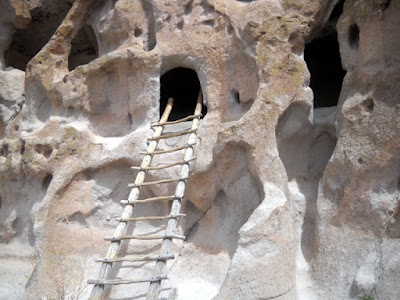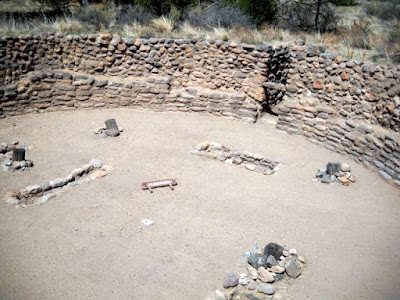
The Visitor Center is newly remodeled and updated inside and a brand new introductory video, five years in the making, is outstanding. If you visit, don't miss it.
The canyon and mesa country is part of the Pajarito Plateau, formed by violent eruptions of the Jemez Volcano more than one million years ago. The eruptions covered the 400-square-mile area with a layer of volcanic ash up to 1,000 thousand feet thick. The pink rock of the canyon is volcanic ash that compacted over time into a soft, crumbly rock called tuff. This is easily eroded by wind and rain, taking on a "Swiss Cheese" appearance. (This paragraph was written especially for you, Eric.)[Our son Eric teaches earth science to middle school students.]

The Ancestral Pueblo people built structures against the canyon walls, where they could enlarge the small holes, carving out "cavates" to use as additional rooms and storage areas for their buildings.

This reconstruction shows the rock and masonry walls of the buildings and the ceiling beams.

They built fires in the cavates to harden the ceiling surface.

Today some of the cavates are open to the public via these ladders.

There was a surprisingly large number of visitors at Bandelier this week.

In addition to the buildings against the canyon walls, the ancient people built a large circular pueblo on the canyon floor. Here you can see remaining first-floor walls of the pueblo.

This Kiva is located outside the confines of the pueblo.

Farther up the canyon they built an 800-foot-long stretch of canyon wall structures called Long House. Here you can see some of the cavates (rooms), as well as the rows of holes in the canyon wall that show where beams for ceilings were placed. You can see two rows of holes for two stories here.

This shows both the lower walls of the buildings and the canyon wall rooms.

In this area, we could see some faint petroglyphs.

Archaeologists also discovered this picture, which had been painted on the canyon wall then covered over by plaster.

Frijoles Creek is the year-round source of water that probably attracted the ancestral Puebloans to this canyon.

We walked another half mile up the canyon to see Alcove House. To reach it, we had to climb stairs and ladders 140 feet up the canyon wall. I wondered if we had wandered back to Picacho Peak in Arizona.


It really wasn't as bad as it looks here.

glad it was you who took the steps; I would give you my camera. And watch from below. At times, bad knees are not so bad after all!!
ReplyDeleteYou know I don't think I've ever been to Bandelier. It looks pretty interesting. Glad we could warm you up for it. :-)
ReplyDelete